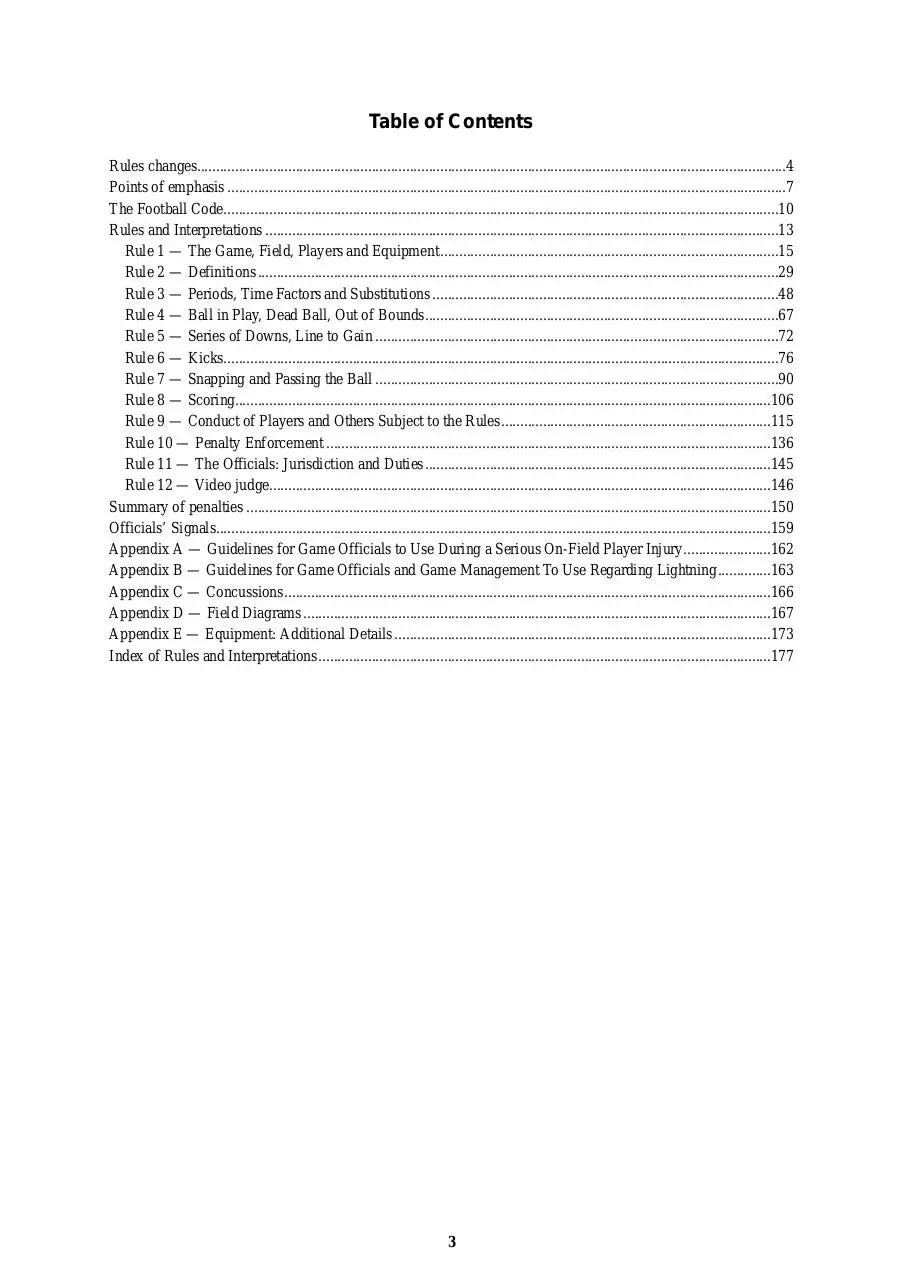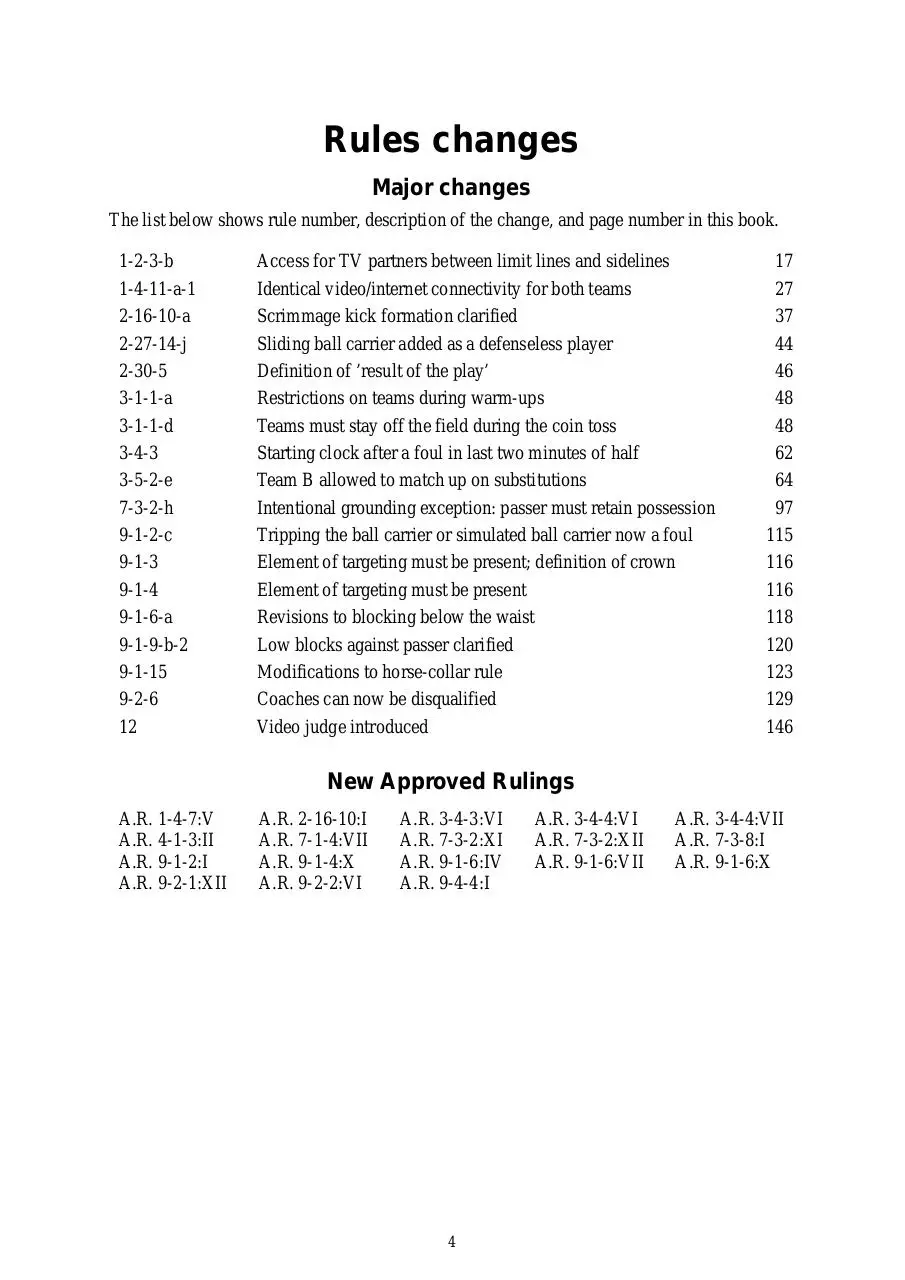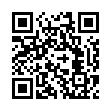IFAFRules2017 01 (PDF)
File information
Title: Untitled
This PDF 1.4 document has been generated by UnknownApplication / GPL Ghostscript 9.05, and has been sent on pdf-archive.com on 13/01/2017 at 21:55, from IP address 189.62.x.x.
The current document download page has been viewed 592 times.
File size: 1.53 MB (183 pages).
Privacy: public file





File preview
INTERNATIONAL
FEDERATION OF
AMERICAN FOOTBALL
FOOTBALL RULES
AND
INTERPRETATIONS
2017 EDITION
2017.2.1
Foreword
The rules are revised each year by IFAF to improve the sport’s level of safety and quality of play, and to clarify
the meaning and intent of rules where needed. The principles that govern all rule changes are that they must:
•
be safe for the participants;
•
be applicable at all levels of the sport;
•
be coachable;
•
be administrable by the officials;
•
maintain a balance between offense and defence;
•
be interesting to spectators;
•
not have a prohibitive economic impact; and
•
retain some affinity with the rules adopted by NCAA in the USA.
IFAF statutes require all member federations to play by IFAF rules, except in the following regards:
1.
national federations may adapt Rule 1 to meet local needs and circumstances, provided no adaption
reduces the safety of the players or other participants;
2.
competitions may adjust the rules according to (a) the age group of the participants and (b) the gender of
the participants;
3.
competition authorities have the right to amend certain specific rules (listed on page 13);
4.
national federations may restrict the above so that the same regulations apply to all competitions under
their jurisdiction.
These rules apply to all IFAF organised competitions and take effect from 1st March 2017. National federations
may adopt them earlier for their domestic competitions.
For brevity, male pronouns are used extensively in this book, but the rules are equally applicable to female and
male participants.
2
Table of Contents
Rules changes...........................................................................................................................................................4
Points of emphasis ...................................................................................................................................................7
The Football Code..................................................................................................................................................10
Rules and Interpretations .......................................................................................................................................13
Rule 1 — The Game, Field, Players and Equipment.........................................................................................15
Rule 2 — Definitions .........................................................................................................................................29
Rule 3 — Periods, Time Factors and Substitutions ...........................................................................................48
Rule 4 — Ball in Play, Dead Ball, Out of Bounds.............................................................................................67
Rule 5 — Series of Downs, Line to Gain ..........................................................................................................72
Rule 6 — Kicks..................................................................................................................................................76
Rule 7 — Snapping and Passing the Ball ..........................................................................................................90
Rule 8 — Scoring.............................................................................................................................................106
Rule 9 — Conduct of Players and Others Subject to the Rules.......................................................................115
Rule 10 — Penalty Enforcement .....................................................................................................................136
Rule 11 — The Officials: Jurisdiction and Duties ...........................................................................................145
Rule 12 — Video judge....................................................................................................................................146
Summary of penalties ..........................................................................................................................................150
Officials’ Signals..................................................................................................................................................159
Appendix A — Guidelines for Game Officials to Use During a Serious On-Field Player Injury.......................162
Appendix B — Guidelines for Game Officials and Game Management To Use Regarding Lightning..............163
Appendix C — Concussions................................................................................................................................166
Appendix D — Field Diagrams ...........................................................................................................................167
Appendix E — Equipment: Additional Details ...................................................................................................173
Index of Rules and Interpretations .......................................................................................................................177
3
Rules changes
Major changes
The list below shows rule number, description of the change, and page number in this book.
1-2-3-b
1-4-11-a-1
2-16-10-a
2-27-14-j
2-30-5
3-1-1-a
3-1-1-d
3-4-3
3-5-2-e
7-3-2-h
9-1-2-c
9-1-3
9-1-4
9-1-6-a
9-1-9-b-2
9-1-15
9-2-6
12
Access for TV partners between limit lines and sidelines
Identical video/internet connectivity for both teams
Scrimmage kick formation clarified
Sliding ball carrier added as a defenseless player
Definition of ’result of the play’
Restrictions on teams during warm-ups
Teams must stay off the field during the coin toss
Starting clock after a foul in last two minutes of half
Team B allowed to match up on substitutions
Intentional grounding exception: passer must retain possession
Tripping the ball carrier or simulated ball carrier now a foul
Element of targeting must be present; definition of crown
Element of targeting must be present
Revisions to blocking below the waist
Low blocks against passer clarified
Modifications to horse-collar rule
Coaches can now be disqualified
Video judge introduced
17
27
37
44
46
48
48
62
64
97
115
116
116
118
120
123
129
146
New Approved Rulings
A.R. 1-4-7:V
A.R. 4-1-3:II
A.R. 9-1-2:I
A.R. 9-2-1:XII
A.R. 2-16-10:I
A.R. 7-1-4:VII
A.R. 9-1-4:X
A.R. 9-2-2:VI
A.R. 3-4-3:VI
A.R. 7-3-2:XI
A.R. 9-1-6:IV
A.R. 9-4-4:I
4
A.R. 3-4-4:VI
A.R. 7-3-2:XII
A.R. 9-1-6:VII
A.R. 3-4-4:VII
A.R. 7-3-8:I
A.R. 9-1-6:X
Rules changes
5
Editorial changes
The following list shows those rules that have been subject to editorial change, i.e. deletions,
corrected errors, clarifications due to interpretation and items rewritten for readability. The
list also includes those Approved Rulings altered to conform with rule changes.
1-1-7-b
1-4-5-a-2
2-3-1-a
2-19-2-a
A.R. 2-30-4:II
3-1-3-f
3-3-5-b
3-3-9-b-2
4-1-4
A.R. 6-1-3:II
A.R. 6-3-4:I
A.R. 6-3-4:V
6-3-13
A.R. 6-5-4:I
A.R. 7-1-4:V
7-1-5-a-3
A.R. 7-3-4:II
7-3-10
A.R. 8-3-2:V
A.R. 8-3-4:III
A.R. 9-1-6:VIII
A.R. 9-1-14:III
A.R. 9-2-1:VIII
A.R. 9-3-3:VIII
A.R. 10-1-5:II
A.R. 10-2-2:V
10-2-3
A.R. 10-2-5:VI
1-1-7-c
1-4-5-c-2
A.R. 2-4-3:II
2-19-2-c
2-35-1
A.R. 3-1-3:XII
3-3-6
3-4-2-b-2
A.R. 5-2-3:I
6-1-8
A.R. 6-3-4:II
A.R. 6-3-11:III
A.R. 6-4-1:II
7-1-1-b
A.R. 7-1-4:VI
A.R. 7-1-5:I
7-3-7-c
A.R. 7-3-10:II
A.R. 8-3-2:VIII
A.R. 9-1-6:II
A.R. 9-1-7:I
A.R. 9-1-16:III
9-2-2-d
9-3-6-Exception-1-a
A.R. 10-2-2:I
A.R. 10-2-2:VIII
10-2-4
10-2-7-b
1-2-2
1-4-6-b-2
A.R. 2-4-3:III
2-25-8
2-35-1-c
A.R. 3-2-3:VII
3-3-7
3-4-4-a
A.R. 5-2-6:I
A.R. 6-2-1:I
A.R. 6-3-4:III
A.R. 6-3-11:IV
A.R. 6-4-1:III
A.R. 7-1-2:IV
7-1-5-a
7-3-2-e
7-3-8-b-1
A.R. 7-3-11:II
A.R. 8-3-2:IX
A.R. 9-1-6:III
A.R. 9-1-14:I
A.R. 9-1-16:VI
A.R. 9-2-2:I
A.R. 9-4-1:III
A.R. 10-2-2:III
A.R. 10-2-2:IX
10-2-5-a-1
11-1-1
1-4-2 Penalty
1-4-6-d-2
A.R. 2-4-3:IV
2-27-12-b
3-1-3-e
A.R. 3-3-2:VII
3-3-8
A.R. 3-4-4:II
A.R. 6-1-3:I
A.R. 6-3-1:III
A.R. 6-3-4:IV
A.R. 6-3-11:V
A.R. 6-5-1:I
A.R. 7-1-3:IV
7-1-5-a-2
A.R. 7-3-2:IV
A.R. 7-3-8:IV
A.R. 7-3-12:I
A.R. 8-3-4:I
A.R. 9-1-6:V
A.R. 9-1-14:II
9-2-1-a-1
A.R. 9-2-3:I
A.R. 9-4-1:X
A.R. 10-2-2:IV
A.R. 10-2-2:X
10-2-5-a-2
Summary of differences between NCAA and IFAF rules
* indicates a new difference in 2017
NCAA Rule
1-2-5-f
1-4-11
2-16-10-a
2-27-12
3-1-1
3-1-1-d
3-2-4
3-2-5
IFAF difference
Procedure for dealing with missing goals.
Film and video are allowed for coaching purposes (NCAA not until 2017).
Cameras allowed on officials. Drones prohibited.
Punter needs only be 7 yards deep; kicker/holder need only be 5 yards deep
to count as a scrimmage kick formation. *
Whether a disqualified player is suspended for the next game is matter for
the disciplinary authority.
Pre-game warmups not subject to the rules.
During coin toss, teams must remain in the team area. *
Play clock reset only if it drops below 20 seconds before ball ready.
No minimum time for a play after spiking.
6
Rules changes
NCAA Rule
3-3-2
3-3-7
3-3-8
4-1-2-b
4-1-3
6-1-7-b/8-6-2
7-2-5
9-1-3&4/9-5-1
9-2-2-d
9-2-2-e
9-2-7
9-6
12
IFAF difference
Running clock.
No short timeouts. *
Two-minute warning cannot happen before 2’00.
Ball may belong to recovering team after inadvertent whistle.
Ball is dead if players in vicinity believe it is.
All touchbacks are from the 20-yard line.
Fumble/backward pass at rest awarded according to forward fumble
principles.
No half-game suspensions.
Two players in same position can wear the same number.
Penalty for wearing illegal cleats does not include charging a team timeout.
*
Referee may require persons to be removed from the playing enclosure.
Flagrant unsportsmanlike conduct fouls can be reviewed for additional
sanctions.
Video judge rule. *
This list ignores differences that address field limitations, NCAA competition structures (e.g.
conferences) or equipment restrictions. It also ignores minor wording changes that do not
have significant effect on the way the game is played.
Points of emphasis
For 2017, the Rules Committee wishes coaches, players and officials to take particular note
of the following points.
Officiating mechanics
IFAF has adopted, on the recommendation of the Rules Committee, a change to Rule 11-2-2
regarding officiating mechanics. Officiating responsibilities and mechanics are specified in
the current edition of the Manual of Football Officiating, published by IAFOA. Officials are
responsible for knowing and applying the material in the Manual.
The purpose of the rule change is to standardise officiating mechanics, especially across
different size crews. The IAFOA manual is the only one that covers crew sizes from 3 to 8.
The Rules Committee felt that it was best for officials working international games to do the
same things that they do regularly in their domestic games (as far as possible). Since
domestic games are frequently officiated by 4 or 5-man crews, or in some countries using
larger crews is limited to special occasions, it is important that the responsibilities and tasks
associated with the officiating positions change as little as possible. The one exception to
this principle is obviously that on larger crews, the responsibilities of the crew can be spread
out over more people and each individual official can therefore have less to do.
It is a recipe for disaster for officials who are working in their national competitions for most
weeks of the year to have to switch to a somewhat arbitrarily different set of mechanics for
the one or two weeks of the year when they work international competition.
We hope that in due course all national federations and/or officiating organisations will
choose to standardise their mechanics and so facilitate the effectiveness of their officials in
international competitions. We recognise that this will be difficult for organisations in USA,
Canada and Japan to adopt.
The IAFOA manual is the one previously known as the "BAFRA" manual. An IAFOA
Mechanics Committee has been established, based on the existing international advisory
committee that has determined recent versions.
What IFAF is doing here is simply standardising the way that games are officiated. No other
major international sport has different positioning requirements for its officials. American
football outside the USA (and Canada and Japan for historic reasons) should be no different.
Sideline control
The Rules Committee requires competitions and teams to enforce strictly the rules regarding
the the team area and coaching box (Rule 1-2-4-a, back of the limit lines between the 25-yard
lines), and the space between the limit lines (Rules 1-2-3-a and 1-2-3-c, up to 18 feet outside
the sidelines and the end line) and the sidelines. These field-level locations must be kept
clear of persons who have no game responsibilities.
The field level is not for spectators. It must be reserved for those who are performing a
service associated with action on the field of play and for administration of the game. Simply
put, no job means no sideline pass.
Each team is limited to 25 persons in its team area, not including squad members in full
uniform, who shall be wearing a team credential. (Full uniform is defined as equipped in
accord with IFAF rules and ready to play.)
Persons who are directly involved in the game include (Rules 1-1-6 and 1-2-4-b): coaches,
team managers, medical and athletic training staff members, athletics communications staff
7
8
Points of emphasis
members, and game operations staff members (e.g. chain crew, ball persons, official media
liaisons, technicians responsible for coach-to-press box communications).
While the game is in progress, the area from the limit lines outward to the stadium seating,
outside the team area, should be restricted to credentialed media camera operators and on-air
personnel, cheer team members in uniform, and stadium security personnel in uniform.
Game management personnel and stadium security personnel are responsible for enforcing
these restrictions.
Protection of defenseless players
In 2009, we introduced a separate rule prohibiting forcible contact with the helmet and
targeting a defenseless opponent. These actions are now in two rules: Targeting and Making
Forcible Contact With the Crown of the Helmet (Rule 9-1-3) and Targeting and Making
Forcible Contact to Head or Neck Area of a Defenseless Player (Rule 9-1-4). Use of the
helmet as a weapon and intentional (targeted) contact to the head or neck area are serious
safety concerns. The penalties for fouls under both 9-1-3 and 9-1-4 include automatic
disqualification. We continue to emphasise that coaches and officials must be diligent to
ensure that players understand and abide by these rules.
Rule 2-27-14 defines and lists characteristics of a defenseless player.
Helmets
The helmet is intended to protect the player from head injuries. It must therefore be fitted
properly so that it does not come off through play. Coaches and trainers must be diligent in
seeing that players wear the helmets properly, and officials must firmly enforce the rules
requiring chin straps to be tightly secured. The rules (Rule 3-3-9) now call for the player
whose helmet comes off to leave the game for one down, unless this is the direct result of a
foul. The player may remain in the game if his team is granted a charged timeout.
Safety and medical considerations
IFAF strongly encourages coaches and officials to be diligent in ensuring that players wear
mandatory equipment. It is especially important that equipment and pads cover body parts
for which they were designed. Particular attention is drawn to wearing uniform pants that
cover the knees, which are easily abraded when exposed.
Football players are especially susceptible to methicillin-resistant staphylococcus aureus
(MRSA), which is resistant to commonly used antibiotics. MRSA results in lost playing
time. More seriously, it has caused the deaths of several football players in recent years.
MRSA is typically transmitted through body-to-body contact from an infected wound or via
an object (e.g. towel) that has come in contact with the infected area. It is not transmitted
through the air, is not found on mud or grass, and cannot live on artificial turf.
IFAF recommends observing common medical precautions to reduce the incidence of MRSA
infections, including:
•
Proper wearing of all required padding and uniform equipment.
•
Keep hands clean by washing thoroughly with soap and water, or by using an alcoholbased hand sanitizer routinely.
•
Immediate showering after all physical activity.
•
Avoid whirlpools or common tubs when having an open wound.
•
Proper washing of athletics gear and towels after each use.
•
Referring all active skin lesions to the athletic trainer.
•
Covering all skin lesions appropriately before participation.
Points of emphasis
9
Concussions
Coaches and medical personnel should exercise caution in the treatment of a participant who
exhibits signs of a concussion. See Appendix C for detailed information.
Sportsmanship
After reviewing a number of plays involving unsportsmanlike conduct, we are firm in our
support of the unsportsmanlike conduct rules as they are currently written and officiated.
Many of these fouls deal with players who inappropriately draw attention to themselves in a
premeditated, excessive or prolonged manner. Players should be taught the discipline that
reinforces football as a team game.
IFAF reminds head coaches of their responsibility for the behaviour of their players before
and after, as well as during, the game. Players must be cautioned against pre-game
unsportsmanlike conduct on the field that can lead to confrontation between the teams. Such
action can lead to penalties enforced on the opening kickoff, possibly including
disqualification of players. Repeated occurrence of such unsportsmanlike behaviour by a
team may result in punitive action by IFAF against the head coach and his team.
Download IFAFRules2017-01
IFAFRules2017-01.pdf (PDF, 1.53 MB)
Download PDF
Share this file on social networks
Link to this page
Permanent link
Use the permanent link to the download page to share your document on Facebook, Twitter, LinkedIn, or directly with a contact by e-Mail, Messenger, Whatsapp, Line..
Short link
Use the short link to share your document on Twitter or by text message (SMS)
HTML Code
Copy the following HTML code to share your document on a Website or Blog
QR Code to this page

This file has been shared publicly by a user of PDF Archive.
Document ID: 0000536516.